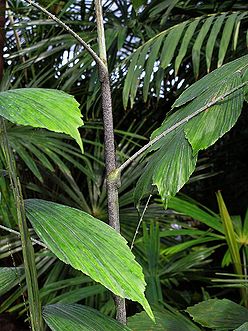Ceratolobus kingianus
| Ceratolobus (sehr-ah-toh-LOH-buhs) kingianus (keen-jee-AHN-uhs) | |||||||
|---|---|---|---|---|---|---|---|
 Nong Nooch Tropical Botanical Garden, Pattaya, Thailand. Photo by Dr. Scott Zona. | |||||||
| Scientific Classification | |||||||
| |||||||
| Synonyms | |||||||
|
| |||||||
| Native Continent | |||||||
|
| |||||||
| Morphology | |||||||
| |||||||
| Culture | |||||||
|
| |||||||
| Survivability index | |||||||
|
| |||||||
| Common names | |||||||
|
| |||||||
Contents
Habitat and Distribution
Malaya. Very local, endemic to the Malay Peninsula, known only from a few collections. In lowland Pahang found in periodically inundated Peat Swamp Forest.Description
Slender clustering rattan 5-8 m long. Stems closely clustering by short suckers, to 8 mm in diam. without sheaths, to 15 mm with sheaths. Internodes about 20 cm in length. Leaf sheaths rather densely whitish-grey-green when young and fresh, drying dull brown, densely covered with greyish-white scurfy indumentum, and crowded partial whorls of easily detached dark brown almost blackish spiculae to 2 mm long borne on pale yellowish-green bulbous bases united into delicate ridges; larger non-spiculate spines apparently very rare, usually absent, and chocolate-coloured scales also absent; geniculus present, rather densely armed with partial whorls of spiculae, these about 0.5-1 mm distant; ocrea 3-5 mm high, sparsely spiculate, tattering with age. Leaf to 1.5 m in all; petiole 12-20 cm long, rounded abaxially, flattened adaxially, with rather sparse scattered groups of spiculae and dense rigid prickles about 3-4 mm high on all surfaces, those on the lower surface, larger and usually reflexed; grey-white indumentum sparse, usually absent; rachis very sparsely armed adaxially, abaxially with scattered spines, or reflexed grapnel hooks in 3's to 5's, these continuing along the cirrus where about 1 cm distant; whole cirrus about 30-55 cm long. Leaflets 4-6 on each side of the rachis in the mature leaf, the lowermost as large as or larger than the rest, alternate throughout the length of the rachis; the largest to 25 x 11 cm, usually smaller and narrower; upper leaflet margins praemorse with rather rounded and distant lobing, rather obtuse or sometimes long-acuminate, whole leaflet markedly plicate with up to 10-12 plications; leaflets dull green above, sparsely white indumentose below or just faintly discolorous, not densely white indumentose, with scattered pale brown pseudo- parenchymatous scales along ribs on the upper surface; transverse veinlets rather obscure. Young leaves flushed pink on emergence, quickly turning dull green.| read more |
|---|
| Staminate and pistillate inflorescences superficially similar, sessile, erect, 21-31 x 4-6.5 cm, relatively rather broad; base of inflorescence at point of insertion about 5 mm wide and 3 mm through. Prophyll pale pinky-green on first emergence, then drying pale cinnamon-brown, when young with very sparse caducous white indumentum, chocolate-coloured scales absent, slightly toothed on margins below, a few scattered spiculae sometimes present on the abaxial surface near the base; beak about 2 cm long by about 8 mm wide at the base, rather robust. Axis with up to 8 first-order branches to 8 cm long below, decreasing above; first-order bracts tightly sheathing, to 3 mm long in sheathing portion, with long triangular apiculus to 8 mm long, pale brown. Staminate flowers solitary, borne on an alveolus 0.75 mm in diam.; calyx with shallowly triangular lobes about 0.75 mm long; corolla about 3 mm long split almost to the base into 3 lobes about 3 mm x 1.25 mm near the base, tapering to a rather bluntly triangular tip; stamens 6, minutely epipetalous with filaments about 1.25 mm long, bearing medifixed anthers about 2 x 0.2 mm (only immature flowers available); pistillode minute. Pistillate flower unknown-but corolla persisting in fruit, with petals triangular about 4 x 2.5 mm (in Beccari, described but without dimensions). Sterile staminate flower unknown to me (-in Beccari, described as 6 mm long). Fruit at maturity globose, about 1.5 cm in diam., tipped by the stigmatic remains and covered in 12 vertical rows of dark chestnut-brown scales with darker marginal lines; seed rounded, about 1 cm in diam., slightly depressed laterally, covered with a thin sarcotesta; endosperm with dark brown ruminations penetrating to 1.5 mm deep; embryo basal. Eophyll not known (J. Dransfield, A monograph of Ceratolobus (Palmae). 1979)/Palmweb. Editing by edric.
Beccari did not indicate which of Kunstler 2547, 2856 or 5589 or Wray 2869 represented the type. The Florence specimen of Kunstler 2856 is here designated lectotype. Material of rhomboid-leafleted species of Ceratolobus from the Malay Peninsula is very sparse; however what material is available is rather uniform and suggests that there is one taxon only in this group in Malaya. It must be borne in mind that collections in the future may show variation which links up with the variation found in discolorous rhomboid-leafleted species in Sumatra and Borneo. However, based on material available at present, the Malayan taxon appears distinct from C. discolor and is retained as C. kingianus though it is admitted that the characters used for separating this taxon are somewhat relative (viz.-relative size of leaflets and stem, and relative abundance of indumentum). (J. Dransfield, A monograph of Ceratolobus (Palmae). 1979)/Palmweb. |
Culture
Cold Hardiness Zone: 11
Comments and Curiosities
- IMAGE GALLERY
External Links
References
Phonetic spelling of Latin names by edric.
Special thanks to Geoff Stein, (Palmbob) for his hundreds of photos.
Special thanks to Palmweb.org, Dr. John Dransfield, Dr. Bill Baker & team, for their volumes of information and photos.
Glossary of Palm Terms; Based on the glossary in Dransfield, J., N.W. Uhl, C.B. Asmussen-Lange, W.J. Baker, M.M. Harley & C.E. Lewis. 2008. Genera Palmarum - Evolution and Classification of the Palms. Royal Botanic Gardens, Kew. All images copyright of the artists and photographers (see images for credits).
J. Dransfield, A monograph of Ceratolobus (Palmae). 1979
Many Special Thanks to Ed Vaile for his long hours of tireless editing and numerous contributions.






